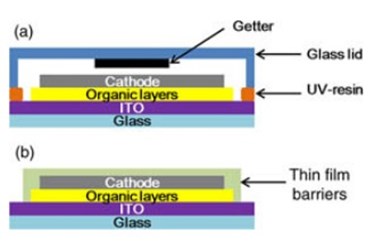New Findings Move Flexible Lighting Technology Toward Commercial Feasibility

Next directions in organic light-emitting diode (OLED) technology for lighting identified in Journal of Photonics for Energy
Imagine illuminating your home or business with flat, inexpensive panels that are environmentally friendly, easy on your eyes, and energy-efficient because they create minimal heat.
Now imagine how those panels could be used if they were as flexible as paper or cloth; the technology could be bent into shapes, fit the interior or exterior curves of vehicles, even be incorporated into clothing.
In "Flexible organic light-emitting diodes (OLEDs) for solid-state lighting" a team of researchers at Pohang (Republic of Korea) University of Science and Technology reports on advances in three key areas - flexible electrodes, flexible encapsulation methods, and flexible substrates -- that make commercial use of such technology more feasible and closer to implementation. The article appears in the current issue of the Journal of Photonics for Energy, published by SPIE, the international society for optics and photonics.
OLEDs show promise as a future light source because of their thinness, light weight, energy efficiency, and use of environmentally benign materials. Companies such as Philips and LG Chemical have begun producing flat OLED panels that produce non-glare, UV-free light but very little heat, with no need for lamp shades or diffusers.
"The future trend in OLEDs is to make them on plastic substrates for flexibility, durability, and light weight. In this work, the authors review the technical challenges and solutions in this important subject," said Franky So, Walter and Ida Freeman Distinguished Professor in Materials Science and Engineering at North Carolina State University, and an associate editor of the journal.
Min-Ho Park and other researchers at Pohang tested a variety of transparent electrodes as flexible alternatives to currently available devices based on indium tin oxide (ITO), which is brittle and increasingly expensive, and identified next steps toward making flexible solid-state lighting commercially feasible:
development of a flexible electrode that has high electrical conductivity, high bending stability, few defects, smooth surface texture, and high work function
reduction in the water-vapor transmission rate of materials used, to counter the vulnerability of OLEDs to moisture.
OLEDs produce light by sending electricity through one or more thin layers of an organic semiconductor, which may be composed of any of a variety of materials and as small a as a molecule. The semiconductor is sandwiched between a positively charged electrode and a negatively charged one. These layers are deposited on a supporting surface called a substrate, and protected from exposure to the air by a thin layer of encapsulants (traditionally glass).
The Pohang team demonstrated good electrical, optical, and mechanical performance with flexible electrodes fabricated using graphene, conducting polymers, silver nanowires (AgNWs), and dielectric-metal-dielectric (DMD) multilayer structures.
However, various obstacles still remain with these devices' durability, conductivity, surface roughness, and fabrication cost. Current flexible substrates and encapsulation methods are being explored, with the goal of reducing cost and processing time, and increasing durability.
The Journal of Photonics for Energy covers fundamental and applied research areas focused on the applications of photonics for renewable energy harvesting, conversion, storage, distribution, monitoring, consumption, and efficient usage. Editor-in-Chief Zakya Kafafi is adjunct professor in electrical and computer engineering at Lehigh University.
The journal is published digitally in the SPIE Digital Library, which contains more than 430,000 articles from SPIE journals, proceedings, and books, with approximately 18,000 new research papers added each year.
About SPIE
SPIE is the international society for optics and photonics, an educational not-for-profit organization founded in 1955 to advance light-based science and technology. The Society serves nearly 264,000 constituents from approximately 166 countries, offering conferences and their published proceedings, continuing education, books, journals, and the SPIE Digital Library in support of interdisciplinary information exchange, professional networking, and patent precedent. SPIE provided more than $4M in support of education and outreach programs in 2014. For more information, visit www.spie.org.
Source: SPIE
